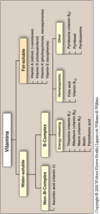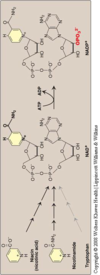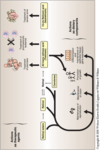4 - Vitamin Flashcards
(41 cards)
Vitamins
- Vitamins might be best understood within the context of phytonutrients. These phytochemicals can play major roles as physiological effectors, some of which range from toxic to beneficial
- While optimal amounts of vitamins are essential for health, no specific phytonutrient is considered to be essential for health
- Vitamins are not everything for nutrition - it is merely just a bare minimum
- Mediterrenean diet helps the longevity of the telomere length and its because of the associated factors to vitamin, NOT the vitamin itself.
- There are phytochemicals that are harmful i.e. don’t eat too much of one food; the purpose for them is for defense
- Some are very beneficial to the point they are designated phytomedicinal
Some classes of phytonutrients include the following:
- Anthraquinones
- Carotenoids (just know this one)
- Flavanoids
- Glucosinolates
- Phytates
- Lignans
- Phenol Acids
- Phytosterols
- Saponins
- Sulfides
- Terpenoids
- Etc.
Some of the health promoting effects of phytonutrients include the following:
- Some of the health promoting effects of phytonutrients include the following:
- Detoxification of carcinogens
- Antioxidation
- Promotion of immune response
- Alteration of estrogen metabolism
- Apoptosis
- DNA repair
- Inhibition of inflammation
- Inhibition of microbial adhesion
- Antomicrobial effects
- There is a range in the “optimal” amount of each vitamin, ranging from about 3 micrograms (vitamin B12 for 45 year old adult) to about 90 milligrams (vitamin C for 45 year old male) - don’t have to know the numbers
- There is also an “individuality factor,” which is affected by such variables as age, gender, size, diet, physiological status, genetics, etc.
Classification of vitamins
Refer the vitamins by the names not the numbers

Measuring vitamin content in body
- It is difficult to accurately measure circulating vitamin levels, as these determinations might reflect recent intake
- Given that water soluble vitamins are coenzymes, these vitamins are generally measured in stimulation tests. Enzyme activity is determined. What is the next step? How do you think that this test would be informative?
- They measure the amount of coenzymes, which includes vitamin, in your body; if you are deficient in the vitamin (a coenzyme) then you would expect to see the more efficient utilization of the coenzyme; the more activity there is, the more deficient you are .
Glutamate residues
- Folic acid consists of pteroic acid (pteridine + para-aminobenzoic acid) and a small number of glutamate residues
- Polyglutamate forms are hydrolyzed to the monoglutamate form in the lumen of the intestine. This form is subsequently absorbed and reduced by dihydrofolate reductase to the active coenzyme, tetrahydrofolate (THF).
- Glutamate chopped out and become active in its role?
-
THF’s role is serving as a carrier of one-carbon units. These are essential in such processes as:
- The synthesis of purine nucleotides
- The thymidylate synthase reaction
- Sulfonamides, which are structural analogs of PABA, serve as antimicrobials

Nutritional Anemias

Deficiencies
- Folate deficiency results in an impairment of DNA replication. A major symptom of this deficiency is the production of megaloblasts (oversized erythrocyte precursors in the bone marrow) and macrocytes (oversized erythrocytes in the blood). This megaloblastic and macrocytic anemia is caused by a reduction of cell division in the presence of normal cytoplasmic growth. (not enough DNA to properly divide into two)
- Megaloblastic anemia can be caused by a deficiency of vitamin B12 and/or folate
- B12 and folic acid work very closely together
- -blast = “immature”

Folate deficiencies
- Pregnancy necessitates an increase of the amount of folate required. Folate deficiencies can result in neural tube defects, such as spina bifida and anencephaly.
- Anencephaly is much worse (affecting head) than spina bifida (affecting bottom)
- Adequate amounts of folic acid could possibly reduce by up to 70% the risk of having a child with spina bifida.
Folate deficiencies can be caused by the following:
Folate deficiencies can be caused by the following:
- Alcoholism -
- Interference with folateabsorption caused by defective replication of the epithelial mucosa extending from the oral cavity through small intestine
- Interference with folate metabolism
- Enhancement of renal excretion
- in general causes problems with anything associated with Vitamin B
- Lack of vitamin B leads to lesions in mouth also.
- Intestinal malabsorption
- Anticonvulsant therapy
- Pregnancy
- Using up more folate during pregnancy for the baby
- Diet or lack there of in some countries
- Eating disorders
- Etc.
Folate and Vitamin B12
- The functions of folate and Vitamin B12 are very closely inter-related
- Both vitamins are involved in the conversion of homocysteine to methionine
- Vitamin B12 also possesses an additional folate-independent function.
- You need both vitamins for the process; folate and vitamin B12

Tetrahydrofolate Trap
- The tetrahydrofolate trap reflects the interdependence of folate and vitamin B12. A deficiency of vitamin B12 can result in the accumulation of N5 methyltetrahydrofolate, without the generation of the active tetrahydrofolate
- Folate is “trapped” in the initial state
- Not enough B12, folate won’t work either
- High levels of homocysteine constitute an independent risk factor for heart disease.
- However, it has not been shown that the reduction of homocysteine levels reduces the risk of death from heart disease
- Impairment of the above reactions can lead to defects in many processes, especially nucleic acid biosynthesis (regarding folate) and neurotransmitter biosynthesis (asso. with Vitamin B12)

Cobolamin (Vitamin B12)
- Vitamin B12 is known as cobolamin. It is the most chemically complex of all vitamins.
- Cobol- = “cobalt”
- Cobalamin possesses a ring structure similar to the porphyrin system of heme.
- There is no other known physiological function of cobalt in the human body.
- Only time we need cobalt in our body

B12 absorption
- The absorption of B12 requires the intrinsic factor, a 50 kD glycoprotein secreted by the gastric parietal cells. The vitamin binds to the IF and is absorbed into the ileum by receptor-mediated endocytosis.
- Absence of Intrinsic factor, no B-12 absorbed
- IF specifically binds to B12
- Autoimmune destruction of the gastric parietal cells leads to a deficiency of vitamin B12, resulting in pernicious anemia, characterized by a macrocytic anemia. In the absence of IF, less than 1% of the B12 can be absorbed. The treatment consists of administering very large doses of B12.
-
Cobalamin is produced by bacteria.
- Bacteria is synthesizing cobalamin; the vitamin is also found in diet but ultimately, bacteria is responsible for the adequate amount of vitamin we actually need.
- Cobalamin is not found in plants. It can be concentrated in the livers of animals.

Vitamin C
- Humans are among the animals that have lost the ability to synthesize ascorbic acid (Vitamin C)
- Primates, fruit bats, guinea pigs lost the ability but most animals still have the capacity
-
Ascorbic acid is a reducing agent. It keeps iron- or copper-containing enzymes in a reduced state in the following representative reactions to synthesize Vitamin C (L-ascorbic acid) from glucose:
- The synthesis of bile
- The synthesis of dopamine
- The hydroxylation of lysyl and prolyl residues in procollagen
- The synthesis of carnitine (fatty acid shuttle)
- The reduction of ferric iron to ferrous iron is essential for its absorption in the gut

Deficiency of Vitamin C
- A deficiency of Vitamin C can lead to scurvy. Symptoms of scurvy include the following:
- Cutaneous petechiae and purpura
- Follicular hyperkeratosis (too much keratin)
- Other symptoms such as dry mouth, dry eyes, gingivitis, anemia, fatigue, etc.
- Benefits of Vitamin C megadoses have NOT yet been proven
Vitamers
- Vitamin B6 refers to the active coenzyme, pyridoxal phosphate, as well as to its dietary precursors: pyridoxine, pyridoxal, and pyridoxamine.
- Vitamers = different froms of vitamin
- e.g. Isoniazid = anti-tuberculosis
- Functions of B6 include the following:
- Synthesis of certain neurotransmitters such as serotonin, norepinephrine, and GABA (gamma-aminobutyric acid) - no need to know spcific neurotransmitters
- Production of niacin from tryptophan
- About half of all the total pyridoxine is bound to muscle glycogen phosphorylase (breaking down)
- Deficiencies can be caused by the following:
- Alcoholism
- Certain drugs including
- Oral contraceptives
- Isoniazid (used in the treatment of tuberculosis)
- The metal chelator (grabs onto metals), penicillamine (used in the treatment of Wilson’s Disease)
- Thiamine (sulfur + amine) functions as thiamine pyrophosphate (Thiamine = thiamine pyrophosphate)
- Thiamine pyrophosphate is necessary for the following reaction:
- The conversion of pyruvate to acetyl-CoA by the pyruvate dehydrogenase complex
- Etc.

Structure of thiamine and thiamine pyrophosphate
Structure of thiamine and thiamine pyrophosphate

Thiamine deficiency
- Severe thiamine deficiency is known as beriberi. Beriberi developed in parts of Asia in which the milling and polishing of rice were extensively practiced
- Symptoms of beriberi include: muscle weakness, muscle wasting, delirium, ophthalmoplegia, dementia, cardiac failure
- Beriberi = “I can’t, I can’t”; since absence of thiamine leads to deficiency in acetyl-CoA involved in glycolysis to evetually generate energy
- In the USA today, thiamine deficiency is caused usually by alcoholism.
- The major syndrome is psychiatric-neurological: Wernicke-Korsakoff syndrome
- Inability to transfer current short term memory to long term memory
- The major syndrome is psychiatric-neurological: Wernicke-Korsakoff syndrome
- Deficiencies can be observed among the elderly and those on a restricted diet
- Figure: Reactions that use thiamine pyrophosphate as a coenzyme

Niacin
- “Niacin” refers to the pyrimidine derivatives, nicotinic acid and nicotinamide. Both in the human body and in dietary sources niacin is a constituent of NAD (nicotinamide adenine dinucleotide) and NADP (nicotinamide adenine dinucleotide phosphate)
- Its functions include the following:
- Redox reactions catalyzed by dehydrogenases i.e. NADH
- Reductive biosynthesis i.e. NADPH
-
Endogenous niacin can be also synthesized from dietary tryptophan
- Process is very inefficient (60x the substrate to yield desired amount of product)
- Process requires other B vitamins
- Deficiency of niacin can cause pellagra
- Major symptoms include Dermatitis, Diarrhea, and Dementia; if severe enough, also Death (the 4D’s)
- Niacin can be used pharmacologically to lower cholesterol
- (A recent study showed that a long-acting form of niacin failed to prevent heart attacks and even slightly raised the risk of a stroke when combined with an LDL-lowering medication).
- Niacin flush = face get red.

Reduction of NAD+ to NADH

Riboflavin (Vitamine B2)
- Riboflavin (Vitamin B2) serves as the precursor of Flavin Adenine Dinucleotide (FAD) and Flavin Mononucleotide (FMN)
- Above derivatives function in redox reactions, including peroxisomal enzymes, electron transport chain, TCA cycle
- Riboflavin and its derivatives are light sensitive
- Infants on phototherapy are given riboflavin supplementation
- Milk is stored in opaque container to prevent riboflavin from getting destroyed by light
- Symptoms of riboflavin deficiency include glossitis (tongue), stomatitis (mouth), and sore throat
- Other Vitamin B deficiences may also include oral symptoms

Biotin
- Biotin serves as a coenzyme for carboxylation reactions
- Carboxylation reactions include: pyruvate carboxylase and acetyl-CoA carboxylase
- Biotin is found in 2 forms in food:
- Free vitamin
- Protein bound form, biocytin
- Biotidinase, an intestinal enzyme, releases the biotin from the bound protein
- About 1 in every 6,000 infants is born with a genetic defect in biotidinase
- Biotin deficiency is rare
- Biotin is synthesized by the intestinal flora
- Avidin (“avid”), a glycoprotein found in raw egg whites, prevents the absorption of biotin into the intestine

Pantothenic acid
- Pantothenic acid (pan = everywhere) is a constituent of coenzyme A
- Pantothenic acid is a constituent of the phosphopantetheine moiety in the fatty acid synthase complex
- Pantothenic acid deficiencies are very uncommon and poorly characterized
















